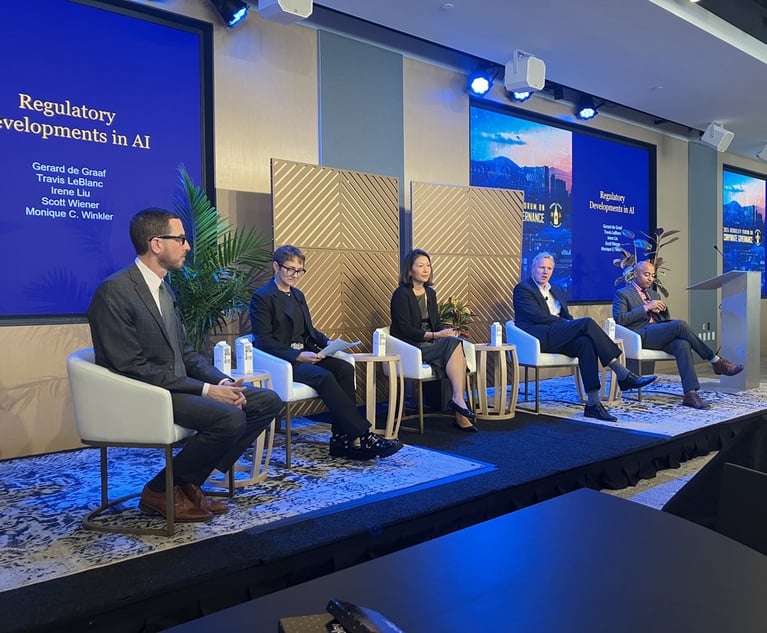Trademark Symbols: Powerful Tools for In-House Counsel?
Though companies often place a high value on protecting their trademarks, some may be missing out on the opportunity to put others on notice of their…
July 12, 2017 at 12:52 PM
4 minute read
The original version of this story was published on Law.com
Though companies often place a high value on protecting their trademarks, some may be missing out on the opportunity to put others on notice of their rights by way of trademark symbols.
For in-house attorneys, proper use of these symbols may not only stave off potential infringers, but in some cases, may also protect the ability to collect damages in an infringement suit.
There are three commonly used trademark symbols: “TM” represents unregistered marks for goods; “SM” represents unregistered marks for services; and a circled “R” is the federal registration symbol that represents a mark that has been registered with the U.S. Patent and Trademark Office.
Use of the symbols may serve as a deterrent for would-be infringers, said Josh Gerben, principal at Gerben Law Firm. “Most of the time, you get this self-policing mechanism out of using the trademark symbols,” he said. “They will typically steer people away from using those trademarks when they know it's the property of someone else.”
Gerben likened use of the symbols to putting on a seat belt. “You put it on every time because you hope if something happens, you have the protection you need,” he said. “Is it a 100 percent required to protect the marks? No … but it just adds more cards in your favor.”
What's more, when it comes to federally registered marks, if a trademark registrant fails to provide proper statutory notice of registration, this will preclude a company from recovering lost profits or money damages in a trademark infringement suit, said Kelley Keller, an associate at Sterne, Kessler, Goldstein & Fox. Proper notice includes actual notice, using the text “Registered in U.S. Patent and Trademark Office” or “Reg. U.S. Pat. & Tm. Off.” or placing the encircled “R” next to the mark, she said, pointing to a specific section of federal trademark law.
“Failure to use [the symbol], I think, can be detrimental in an enforcement proceeding … because it can impact your ability to collect damages,” Keller said. “If you have a registered mark and use the circle R, then you don't have to do anything else to prove that the defendant knew, or should have known, your mark was registered prior to the infringing use.”
As for how these symbols should be used in practice, Keller said when a mark appears in a press release or in other marketing materials, “as a general rule, I think it makes sense to use it just once in a conspicuous place.” She added: “I think it's important that marketing should be consulting with legal all along the way … because legal wants to make sure [a company] has a strong trademark right and it's protected under the law.”
But not everyone is in full support of using trademark symbols. Nonlawyers involved in a branding strategy, such as marketing and press relations teams, don't often like the use of symbols because it can clutter up copy or interrupt the flow of a press release, said Lois Duquette, of counsel at McNees Wallace & Nurick who was formerly associate general counsel of global intellectual property and regulatory at The Hershey Co. She said that some marketers “really don't like what it does to the look” of material so using the marks comes down to balancing legal considerations with concerns of others involved.
And use of symbols can create a “logistical nightmare” for a company operating internationally, Duquette said, because while it may be appropriate to use the circle R symbol in the U.S., the same may not be true in foreign jurisdiction. Some countries may bring administrative actions for improper use of the symbol, she noted.
“It's not fatal to not use the symbol all of the time,” Duquette said. “But the one big benefit if you put [a symbol] on your package or in a press release, is it communicates to the world that this is being used as a trademark.”
Contact Jennifer Williams-Alvarez at [email protected].
This content has been archived. It is available through our partners, LexisNexis® and Bloomberg Law.
To view this content, please continue to their sites.
Not a Lexis Subscriber?
Subscribe Now
Not a Bloomberg Law Subscriber?
Subscribe Now
NOT FOR REPRINT
© 2025 ALM Global, LLC, All Rights Reserved. Request academic re-use from www.copyright.com. All other uses, submit a request to [email protected]. For more information visit Asset & Logo Licensing.
You Might Like
View All
Fatal Shooting of CEO Sets Off Scramble to Reassess Executive Security
5 minute read
Ben & Jerry’s Accuses Corporate Parent of ‘Silencing’ Support for Palestinian Rights
3 minute read
Shareholder Activists Poised to Pounce in 2025. Is Your Board Ready?

Regulatory Upheaval Is Coming. How Businesses Prepare and Respond Will Separate Winners and Losers
Trending Stories
- 1Tensions Run High at Final Hearing Before Manhattan Congestion Pricing Takes Effect
- 2Improper Removal to Fed. Court Leads to $100K Bill for Blue Cross Blue Shield
- 3Michael Halpern, Beloved Key West Attorney, Dies at 72
- 4Burr & Forman, Smith Gambrell & Russell Promote More to Partner This Year
- 5Sanctions Order Over Toyota's Failure to Provide English Translations of Documents Vacated by Appeals Court
Who Got The Work
Michael G. Bongiorno, Andrew Scott Dulberg and Elizabeth E. Driscoll from Wilmer Cutler Pickering Hale and Dorr have stepped in to represent Symbotic Inc., an A.I.-enabled technology platform that focuses on increasing supply chain efficiency, and other defendants in a pending shareholder derivative lawsuit. The case, filed Oct. 2 in Massachusetts District Court by the Brown Law Firm on behalf of Stephen Austen, accuses certain officers and directors of misleading investors in regard to Symbotic's potential for margin growth by failing to disclose that the company was not equipped to timely deploy its systems or manage expenses through project delays. The case, assigned to U.S. District Judge Nathaniel M. Gorton, is 1:24-cv-12522, Austen v. Cohen et al.
Who Got The Work
Edmund Polubinski and Marie Killmond of Davis Polk & Wardwell have entered appearances for data platform software development company MongoDB and other defendants in a pending shareholder derivative lawsuit. The action, filed Oct. 7 in New York Southern District Court by the Brown Law Firm, accuses the company's directors and/or officers of falsely expressing confidence in the company’s restructuring of its sales incentive plan and downplaying the severity of decreases in its upfront commitments. The case is 1:24-cv-07594, Roy v. Ittycheria et al.
Who Got The Work
Amy O. Bruchs and Kurt F. Ellison of Michael Best & Friedrich have entered appearances for Epic Systems Corp. in a pending employment discrimination lawsuit. The suit was filed Sept. 7 in Wisconsin Western District Court by Levine Eisberner LLC and Siri & Glimstad on behalf of a project manager who claims that he was wrongfully terminated after applying for a religious exemption to the defendant's COVID-19 vaccine mandate. The case, assigned to U.S. Magistrate Judge Anita Marie Boor, is 3:24-cv-00630, Secker, Nathan v. Epic Systems Corporation.
Who Got The Work
David X. Sullivan, Thomas J. Finn and Gregory A. Hall from McCarter & English have entered appearances for Sunrun Installation Services in a pending civil rights lawsuit. The complaint was filed Sept. 4 in Connecticut District Court by attorney Robert M. Berke on behalf of former employee George Edward Steins, who was arrested and charged with employing an unregistered home improvement salesperson. The complaint alleges that had Sunrun informed the Connecticut Department of Consumer Protection that the plaintiff's employment had ended in 2017 and that he no longer held Sunrun's home improvement contractor license, he would not have been hit with charges, which were dismissed in May 2024. The case, assigned to U.S. District Judge Jeffrey A. Meyer, is 3:24-cv-01423, Steins v. Sunrun, Inc. et al.
Who Got The Work
Greenberg Traurig shareholder Joshua L. Raskin has entered an appearance for boohoo.com UK Ltd. in a pending patent infringement lawsuit. The suit, filed Sept. 3 in Texas Eastern District Court by Rozier Hardt McDonough on behalf of Alto Dynamics, asserts five patents related to an online shopping platform. The case, assigned to U.S. District Judge Rodney Gilstrap, is 2:24-cv-00719, Alto Dynamics, LLC v. boohoo.com UK Limited.
Featured Firms
Law Offices of Gary Martin Hays & Associates, P.C.
(470) 294-1674
Law Offices of Mark E. Salomone
(857) 444-6468
Smith & Hassler
(713) 739-1250






